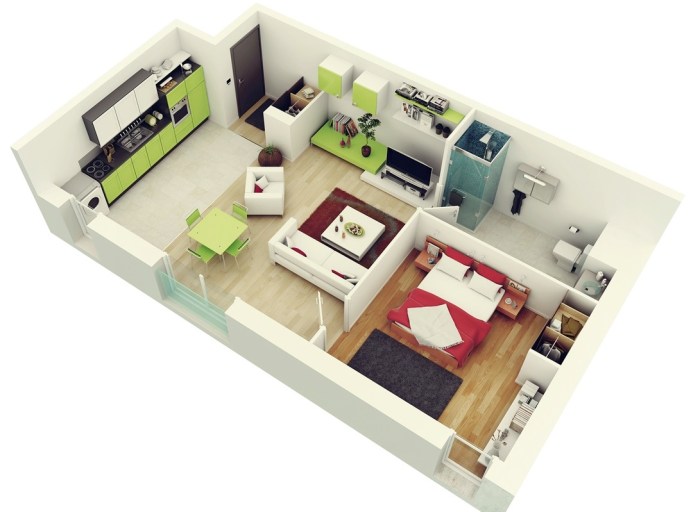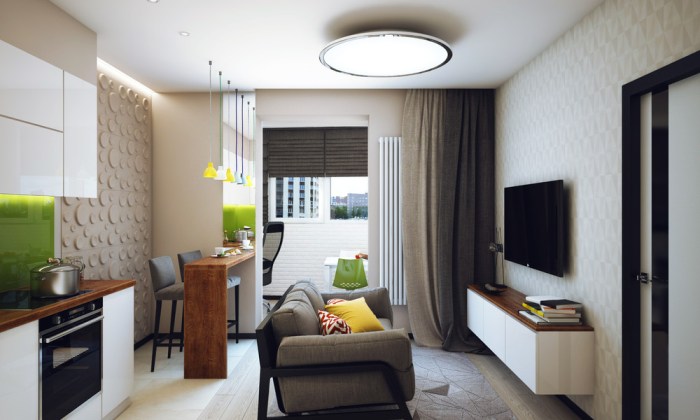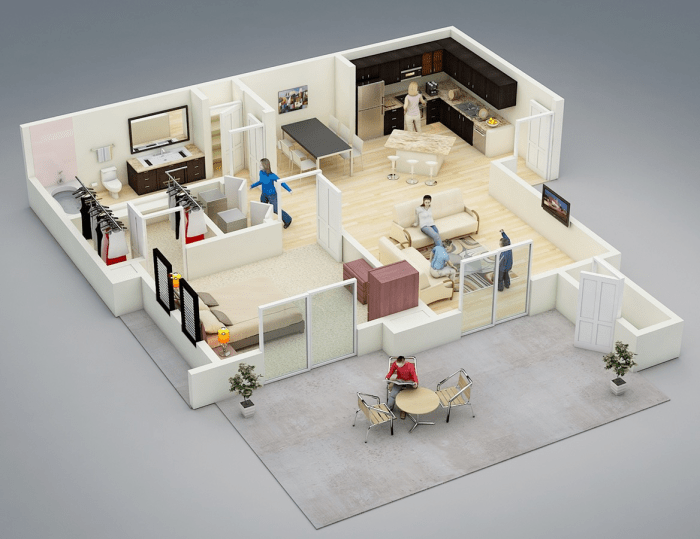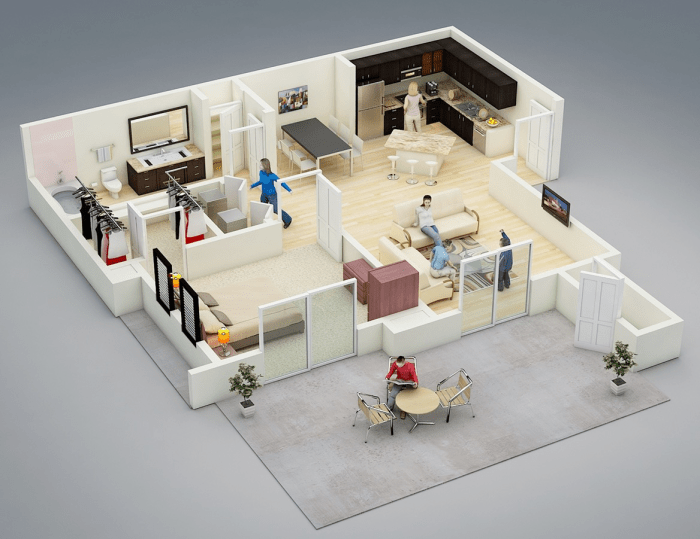1 Bedroom House Interior Design: Creating a Stylish and Functional Space
1 Bedroom house interior design presents a unique challenge: maximizing functionality and style within a limited footprint. This guide explores the art of transforming a small space into a haven of comfort and personality. From clever layout strategies to incorporating multi-purpose furniture, we delve into techniques for optimizing every inch of your home.
Whether you’re starting from scratch or simply seeking inspiration, this guide offers a comprehensive approach to 1 bedroom house interior design. We’ll cover everything from choosing the right color palette and lighting scheme to selecting sustainable materials and adding personal touches that reflect your unique style.
Understanding the Space

A 1-bedroom house is a common choice for individuals or couples seeking a compact and affordable living space. Understanding the typical layout and dimensions of such a house is crucial for effective interior design.
Typical Layout and Dimensions
The layout of a 1-bedroom house typically includes a living room, a bedroom, a kitchen, and a bathroom. The size of each room varies depending on the overall size of the house. However, a typical 1-bedroom house might have a living room area of around 100-150 square feet, a bedroom area of around 100-150 square feet, a kitchen area of around 50-75 square feet, and a bathroom area of around 50-75 square feet.
Common Floor Plan Configurations
There are various floor plan configurations for a 1-bedroom house. Some common examples include:
- Open-plan layout:This configuration combines the living room, kitchen, and dining area into one open space. This creates a sense of spaciousness and allows for flexibility in furniture arrangement.
- Linear layout:This configuration features a series of rooms arranged in a line, with the bedroom at one end and the living room at the other. This layout is ideal for maximizing space and creating a sense of privacy.
- L-shaped layout:This configuration features a living room and kitchen that are connected by a hallway or corridor. This layout offers a good balance of open space and privacy.
Challenges and Opportunities of Designing a Small Living Space
Designing a small living space presents unique challenges and opportunities.
Challenges
- Limited space:The most significant challenge is working with limited space. This requires careful planning and creative solutions to maximize functionality and minimize clutter.
- Storage:Finding enough storage space in a small house can be challenging. Creative solutions like built-in shelves, under-bed storage, and multi-functional furniture are essential.
- Traffic flow:Maintaining a smooth flow of traffic in a small house is crucial to avoid feeling cramped. This requires careful consideration of furniture placement and creating clear pathways.
Opportunities
- Creating a cozy and intimate atmosphere:Small spaces can be made to feel warm and inviting with the right design choices. Using warm colors, soft textures, and comfortable furniture can create a cozy and intimate atmosphere.
- Maximizing natural light:Natural light can make a small space feel larger and brighter. Using large windows, mirrors, and light-colored walls can help to maximize natural light.
- Flexibility and adaptability:Small spaces often require furniture that can be multi-functional and adaptable. Using furniture that can be used for multiple purposes can maximize space and functionality.
Maximizing Functionality
A well-designed furniture layout is crucial for optimizing space utilization and functionality in a one-bedroom house. It’s about creating a balanced and harmonious environment that accommodates all your daily needs.
Designing a Furniture Layout
A well-planned furniture layout is key to maximizing space in a one-bedroom house. It’s not just about fitting everything in, but about creating a flow that enhances functionality. Here are some tips:
- Start with a Floor Plan:Draw a scaled floor plan of your bedroom and mark the location of doors, windows, and any existing fixtures. This will help you visualize potential furniture arrangements.
- Consider Traffic Flow:Ensure there’s enough space for easy movement around furniture. Avoid placing large pieces in the center of the room, as this can make the space feel cramped.
- Multi-Functional Furniture:Utilize pieces that serve multiple purposes, such as a sofa bed or a desk that doubles as a vanity.
- Vertical Space:Utilize vertical space with shelves, cabinets, and storage solutions to minimize clutter and maximize floor space.
- Mirrors:Strategically placed mirrors can create the illusion of more space by reflecting light and opening up the room.
Incorporating Multi-Purpose Furniture
Multi-purpose furniture is a game-changer for maximizing functionality in a one-bedroom house. By selecting pieces that serve multiple functions, you can save valuable space and create a more flexible living environment.
- Sofa Beds:These versatile pieces transform from a comfortable sofa to a bed, ideal for small spaces where you need to accommodate guests or create a dedicated sleeping area.
- Storage Ottomans:These ottomans offer additional seating while providing hidden storage for blankets, pillows, or other items.
- Murphy Beds:These space-saving beds fold away into a wall cabinet when not in use, freeing up floor space for other activities.
- Desk with Storage:Choose a desk with built-in drawers or shelves to keep your workspace organized and clutter-free.
- Folding Tables:These tables can be easily folded away when not in use, perfect for small dining areas or creating a temporary workspace.
Creating Designated Areas
Even in a one-bedroom house, you can create distinct zones for different activities. This helps to define the space and create a sense of order.
- Sleeping Area:Place your bed against a wall, preferably in the furthest corner of the room for privacy and a sense of separation.
- Living Area:Designate a comfortable seating area with a sofa, chairs, and a coffee table. Consider adding a rug to define the space and add warmth.
- Dining Area:If you have a small dining table, place it near a window or in a well-lit corner. Use folding chairs or stools to save space when not in use.
- Working Area:If you work from home, create a dedicated workspace with a desk, chair, and adequate lighting. Place it in a quiet corner of the room to minimize distractions.
Inspiring Examples

To spark your imagination and provide a visual guide, let’s explore a selection of beautifully designed 1-bedroom houses. These examples demonstrate how different design styles can transform a compact space into a stylish and functional haven.
Design Styles and Their Key Features
Understanding different design styles is essential to creating a space that reflects your personality and preferences. Each style carries its own unique aesthetic and functional considerations. Here’s a table highlighting some popular design styles and their key features:
| Style | Key Features |
|---|---|
| Minimalist | Clean lines, neutral colors, simplicity, open space, natural light, functional furniture |
| Scandinavian | Light wood, white walls, natural materials, minimalist furniture, functionality, cozy atmosphere |
| Industrial | Exposed brick, metal accents, reclaimed wood, vintage furniture, raw and unfinished aesthetics |
| Bohemian | Mix of patterns and textures, vibrant colors, eclectic furniture, global influences, personal touches |
| Mid-Century Modern | Geometric shapes, organic forms, warm wood tones, sleek furniture, bold colors, focus on functionality |
Example 1: Minimalist Haven
Imagine a 1-bedroom house where every element is carefully chosen for its simplicity and functionality. The living space features a white sofa with clean lines, a sleek coffee table, and a few strategically placed plants. The bedroom is a sanctuary of calm, with a minimalist bed frame, a bedside table with a lamp, and a soft rug on the floor.
Natural light floods the space through large windows, creating an airy and inviting atmosphere. This minimalist approach emphasizes open space and a sense of tranquility.
Example 2: Scandinavian Cozy Retreat
This 1-bedroom house embraces the warmth and functionality of Scandinavian design. Light wood floors, white walls, and natural materials create a sense of calm and serenity. The living area features a comfortable sofa with soft cushions, a wooden coffee table, and a plush rug.
The bedroom is a cozy haven, with a wooden bed frame, a sheepskin throw, and a reading nook tucked away in a corner. The overall aesthetic is minimalist yet inviting, with a focus on functionality and comfort.
Example 3: Industrial Chic Loft, 1 bedroom house interior design
This 1-bedroom house embraces the industrial aesthetic, showcasing exposed brick walls, metal accents, and reclaimed wood furniture. The living area features a vintage leather sofa, a metal coffee table, and a distressed wooden bookshelf. The bedroom is a mix of modern and vintage elements, with a metal bed frame, exposed brick walls, and a rustic wooden headboard.
The overall aesthetic is edgy and sophisticated, with a focus on raw materials and a sense of history.
Concluding Remarks

Designing a 1 bedroom house interior is a journey of creativity and practicality. By understanding the principles of space optimization, embracing a cohesive design style, and incorporating personal touches, you can create a truly inspiring and functional living space that reflects your individual taste and lifestyle.
FAQ Corner: 1 Bedroom House Interior Design
What are some common challenges of designing a 1 bedroom house?
Common challenges include limited space, balancing functionality with aesthetics, and creating a sense of flow between different areas.
How can I make my 1 bedroom house feel larger?
Use light colors, mirrors, and strategic furniture placement to create an illusion of spaciousness. Incorporate vertical storage solutions to minimize clutter and maximize floor space.
What are some budget-friendly decorating ideas for a 1 bedroom house?
Consider using DIY techniques, repurposing old furniture, and shopping for affordable decor at thrift stores or online marketplaces. Experiment with paint colors and wall treatments to add personality without breaking the bank.

